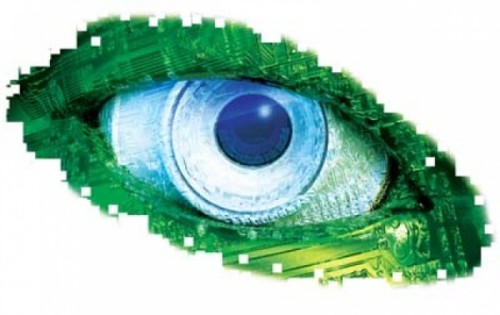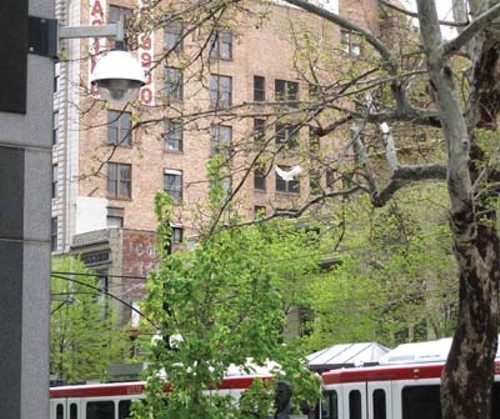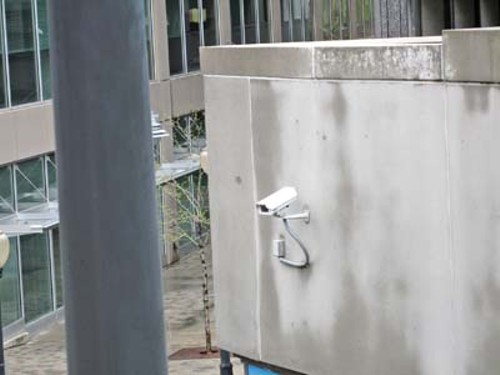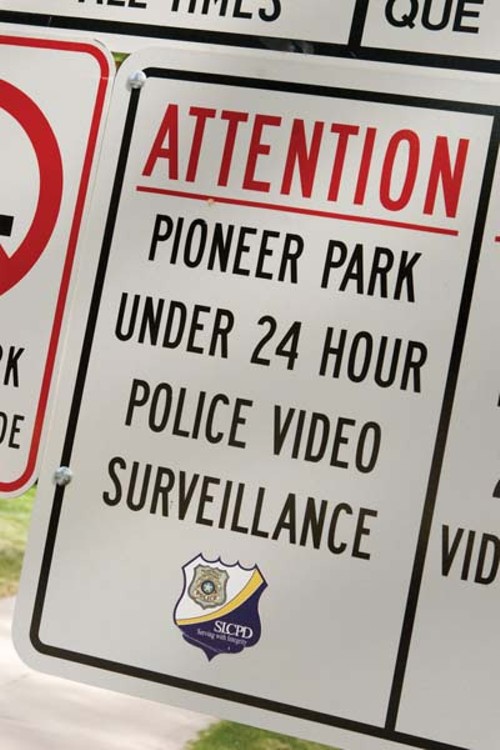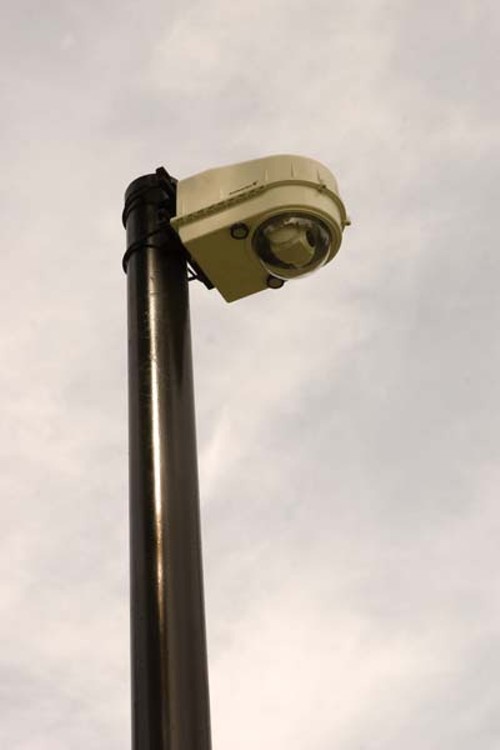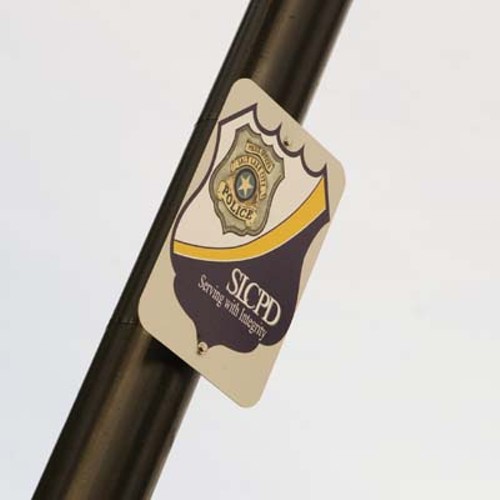They're Watching You
What no one is telling you about the proposed cop shop in Library Square.
By Ted McDonoughWander away from the park with your head tilted up, and you’ll start noticing the half-globe surveillance cameras everywhere: all over Gallivan Plaza, watching the sidewalk outside the now-abandoned Port O’Call, even hanging from a sidewalk streetlight at the intersection of 200 South and West Temple.
Feeling paranoid yet? What if all those security cameras—public and private— were hooked into a central police monitoring station? It’s already happening in cities from Chicago to Dallas, though not yet here, according to the Salt Lake City Police Department.
A few years down the road, however, Utahns might look back on February 2009, when the Pioneer Park cameras began monitoring activities in the square 24/7, as the birth of the city’s new surveillance society in which unblinking lenses watch indoors and out while state supercomputers troll though citizens´ personal electronic information searching for “suspicious activity.”
Already, police cameras peek in at some Salt Lake City businesses. Now, a Utah state program of interlinked state and federal supercomputers mingling data on petty thieves and known terrorists with the personal identity and credit information of lawabiding citizens is set to explode.
|
|
When Salt Lake City watchdog Steve Erickson saw millions of dollars of high-tech spying equipment included on Salt Lake City’s list of “shovel-ready” stimulus projects, it confirmed what he´d been hearing about federal surveillance efforts coming to Utah: facial-recognition technology for Utah Transit Authority buses, an aerial surveillance drone to monitor crowds, hundreds of thousands for wireless surveillance and an artificial-intelligence computer capable of “watching” surveillance cameras for suspicious activity.
“How is spying on Americans creating jobs?” asks Erickson, who, with a small Salt Lake City organization called Citizens Education Project, has been in the forefront trying to keep government surveillance at bay in the Beehive State.
Tall and wiry with a deep-voice, Erickson’s viewpoint on government spying stems from his involvement in student movements during the Vietnam War. Back then, activists were outraged to learn that FBI COINTELPRO agents infiltrated student groups. Forty years on, Erickson sometimes wonders if he’s the only one who cares anymore. He has watched the Utah Fusion Center slowly develop for years but has had little luck trying to pique the interest of public officials.
“If people are comfortable with passive-invasive technology, so be it,” says Erickson. “But some of us old-school boys remember the government dossiers on us during the Vietnam protests.”
One item, in particular, on Salt Lake City’s stimulus wish list caught Erickson’s eye: An $836,000 “shovel ready” project asking for a “software program to search, manage and analyze vast amounts of criminal investigation information from wide ranging data sources” and two police officers to run it. A similar request was described in an April 2009 city grant application as “a technology solution to mining for information collected by state and federal agencies."
It turns out that money is intended for the Utah Fusion Center, a partnership between Utah’s Department of Public Safety, the FBI, the federal Homeland Security Department, the National Guard and local police agencies to create a network of interlinked computer databases and a core of specially trained officers to feed information to the system.
Administered by the state Department of Public Safety, the Utah Fusion Center is part of a network of 60 to 70 fusion centers established throughout the country with $250 million of grants from the terrorism-fighting federal Homeland Security Department. The centers caught flak April 1 during a day of hearings devoted to the program by a congressional Homeland Security committee. Critics warned of America returning to the 1960s where local police “red squads” spied on activists and politicians in the name of rooting out subversives.
The American Civil Liberties Union pointed to political spying already begun by state fusion centers, such as a Texas fusion center asking police to report activities of anti-war protesters and a “threat assessment” from Virginia’s fusion center that called the state’s historically black universities “a radicalization node for almost every type of extremist group.”
In the Beehive State, the Utah Fusion Center—also known as the Statewide Information Analysis Center—has watchdogs and lawmakers shaking their heads for another reason; they have already fought—and defeated—the snooping supercomputers once before.
In 2004, the all-seeing national computer database that promised to find terrorists by combing Americans’ electronic files was called MATRIX, or Multistate Anti- Terrorism Information Exchange. The project was so badly bungled—and so widely pilloried by groups as disparate as the ACLU and the Utah Eagle Forum—that former Utah Gov. Olene Walker made scrapping it one of her first acts after taking office.
Matrix Reloaded
Championed
by former Utah Gov. Mike Leavitt and Florida Gov. Jeb Bush, both
Republicans, MATRIX emerged from the wreckage of Total Information
Awareness, a domestic-spying program proposed in the aftermath of 9/11,
but quickly closed down by Congress in 2003 citing post-Watergate laws
that ban the government from collecting dossiers on lawabiding
Americans.
MATRIX tried to get around the problem by turning
the job of collecting state databases over to a private Florida
company—a private company that just happened to be financed by the
federal Homeland Security Department with grant money obtained by a
former commissioner of the Utah Department of Public Safety.
Public
records obtained in 2004 by Citizens Education Project showed that
Leavitt had signed Utah up for MATRIX and downloaded Utah databases
into the system without telling the Legislature. Utah’s exit was the
beginning of the end for MATRIX, and a panel Walker assembled to review
the program recommended Utah stay away until it worked out “adequate
oversight and appropriate privacy safeguards.”
Fast-forward
five years and it seems the MATRIX, like the 2003 movie sequel, has
been reloaded. A recent public records request by Citizens Education
Project shows that the Utah Fusion Center, in addition to accessing
law-enforcement records, is—like MATRIX—tapping into databases
maintained by private companies that claim to have billions of records
on law-abiding citizens.
Some Utah legislators who served on
former-Gov. Olene Walker’s 2004 MATRIX review committee are
flabbergasted the state is again moving to share its citizens’
information and, yet again, they have heard hardly a peep from the
governor’s office.
State Sen. Gene Davis, D-Salt Lake City,
says the explicit direction from the 2004 committee was to require
future governors to return to the Legislature before moving forward
with the MATRIX or any similar program. Davis isn’t against
law-enforcement agencies sharing information but says, “You have a
certain level of right to privacy. A state database on how many times
you burped when you were a baby, that’s a little alarming to me.”
“With
the way technology is, there is no way to say data can’t be fused,”
says Rep. John Dougall, R-American Fork, another member of the 2004
MATRIX review panel. “But we need to make sure we have the appropriate
constraints on government such that it doesn’t become a reckless
endeavor.”
The Fusion Center
Fusion
centers stem from a call by the 9/11 Commission for more terrorist
information-sharing between law enforcement. The George W. Bush
administration helped with millions for surveillance research and a
rollback of 30-year-old restrictions on government information
gathering.
Federal anti-terrorism state grant programs morphed
over the years to tackle all crime and later “all hazards.” Now, that
money is finally beginning to roll into Salt Lake City. While some Utah
legislators worried about the project becoming a costly unfunded mandate, for now, it seems state and city departments are happy to take the money.
The Utah Fusion Center was formally created in June 2007 when the Utah Department of Public Safety inked a memorandum-of-understanding with the FBI. But it wasn’t much to speak of—just a couple of state investigators sharing joint-terrorism task-force office space with the FBI in downtown Salt Lake City.
That’s changing with recent infusions of federal money. Today, the Utah
Fusion Center consists of five intelligence analysts, a few
administrators and parttime help from a federal Homeland Security
employee. An FBI employee is expected to move in soon. Annual salary
cost for state employees assigned to the fusion center is currently
around $600,000. And Utah recently hired an intelligence officer from a
center in Boston to run the operation.
Fusion-center staff
currently share space with a police training facility at 9750 S. 300
West, at the Larry H. Miller Campus of Salt Lake Community College. But
center directors say the state is talking to Salt Lake City about
moving the operation into one of the buildings the city hopes to
construct on or near Library Square with proceeds from a $125 million
public-safety bond to be taken to city voters in November.
Salt
Lake City Mayor Becker’s plans for a “civic campus” include a
public-safety building for police and fire departments and a separate
Emergency Operations Center built to Homeland Security standards to
withstand an attack by weapons of mass destruction. The full project
could only be realized with help from the state, which would bring in
the fusion center from Sandy and the state’s existing
emergency-operations center from a basement location at the state
Capitol complex. The Salt Lake City Mayor’s Office did not respond to
repeated City Weekly invitations to discuss the city’s involvement with the fusion center.
Whether
or not the state comes up with $40 million to help build the
three-story Emergency Operations Center structure shown in Salt Lake
City plans, the fortress building is scheduled to house the Salt Lake
Information Center, or SLIC, a new project that the Salt Lake City
Police Department hopes to launch by mid-June in current police
department headquarters on 200 South.
Salt Lake City Police
Chief Chris Burbank describes SLIC as a project to connect
law-enforcement records across the Salt Lake Valley with data-searching
software at a central location where police analysts will funnel
investigatory information to officers in the field.
Salt Lake
City Emergency Management Director Cory Lyman describes the pending
SLIC project as “basically Salt Lake’s portion of that [state] fusion
center.”
Mission Creep/ Creepy Missions
Salt
Lake finds itself in the pipeline for federal money for new spyware
purchases and intelligence efforts because of federal funding formulas
that in 2008 determined the Salt Lake Valley faces significant
threat—from earthquakes.
Lyman says the potential for a large
Wasatch Front quake to disrupt rail yards and interstate freeways was
likely “the driving event that put us at risk” in the eyes of Homeland
Security. So in 2008, the feds qualified the Salt Lake metropolitan
area for special grants through a program called the Urban Area
Security Initiative. Salt Lake City is the fiscal agent for the
countywide effort, explaining why initiative requests showed up on the
city’s stimulus wish list.
Last
year, the countywide project received its first infusion of $1.4
million from Homeland Security. In early April, Salt Lake City applied
for another $3 million. Much of the money will be spent on emergency
planning with a portion of all grants going to the Utah Fusion Center.
Salt
Lake Valley’s inclusion in a post-9/11 grant program initially limited
to cities considered at high terror risk highlights a national shift in
fusion centers away from terrorism to the “all-hazards” approach
officially adopted by the Utah Fusion Center. During April’s
congressional fusion center hearings, the national office of the ACLU
echoed earlier critiques of congressional
investigators and Homeland Security auditors by warning of “mission
creep.” It said blending the War on Terror with crime fighting and
private businesses—officially included at the Utah Fusion Center as
“Private Sector Partners”—is a disaster of overzealous law enforcement
waiting to happen.
Fusion centers are basically communications
hubs that allow one-stop access to databases controlled by governments
and private sector “data brokers.” The Utah Fusion Center buys its
noncriminal data from ChoicePoint. As the world’s largest
data-brokering company, its offerings include data on individuals’
insuranceclaim histories, credit information, realestate records,
bankruptcies, professional licenses and historical addresses.
Keith
Squires, Gov. Jon Huntsman Jr.’s adviser on homeland security, says the
information accessed by fusion centers “is already out there”; all the
fusion center does is make it easier to get at the information.
Eventually, the Utah center plans on adding its own internal
intelligence database. But Squires says the center is primarily an
electronic “pointer system” that links to databases maintained by
others. Fusion center critics allege that decentralization is designed
to skirt federal rules against compiling dossiers on innocent
Americans; the centers don’t keep files themselves but can access
information any time with the touch of a keyboard.
Civil
liberty groups also are bothered by the penchant of such programs for
“data mining”—using information technology not to solve a particular
crime but in attempts to find criminals no one knows about.
A
software company associated with the old MATRIX promised its computer
algorithms could search mass databases for common bad-guy profiles and
find “yet unknown terrorists.” A demonstration turned up a few people
already on government watch lists but also spit out the names of
thousands of others presumably ripe for investigation.
The
Utah Fusion Center may be after similar technology. In April, Salt Lake
City submitted a Homeland Security grant on behalf of the center asking
for $780,000 worth of “data gathering, mining, and analysis software to
perform terrorist threat and crime analysis.”
Critics
also question if state and local police are ready to be the Homeland
Security Department’s eyes and ears on the ground. The ACLU pointed to
efforts in some states worthy of The Simpsons’ Chief Wiggum.
Missouri’s
fusion center in February 2009 suggested the “modern militia movement”
could be discovered by investigating people sporting “Ron Paul for
President” bumper stickers. The same month, the geniuses at the North
Texas Fusion Center warned of a terrorist conspiracy combining Muslim
civil-rights organizations, the anti-war movement, hip-hop bands and
2008 Green Party presidential candidate Cynthia McKinney supporters.
Now,
a federal pilot project underway at several state fusion centers
encourages local police to create “suspicious activity reports” and
upload them to the fusion system. Guidelines ask police to document
people taking pictures, appearing lost or espousing “extremist” views.
The
Utah Fusion Center is not part of the pilot project but has launched
the “Intelligence Liaison Officer Program” that will train local law
enforcement throughout the state. Reporting to the Legislature’s
interim Law Enforcement and Criminal Justice committee about the
project in May 2008, Jeff Carr, the Utah Fusion Center’s supervisor at
the Utah Department of Public Safety, noted that a similar program in
Colorado already had nearly 200 officers “feeding information to the
center.” The Colorado program uses utility workers and employees of
private companies in addition to law enforcement.
Intelligence-led Policing
Intelligence-led policing is the new en vogue in law enforcement, and it counts Chief Burbank as a follower.
Salt
Lake City’s police chief looks the part. He keeps his head shaved. He’s
tall and athletic. But he has a ready smile and a friendly, even gentle
demeanor. In fact, if local progressive activists were forced to choose
a lawman to watch them, they might pick Burbank, a Rocky Anderson
appointee recently honored by the ACLU of Utah for publicly defying
Utah’s conservative Legislature and refusing to deputize his officers
as immigrations agents.
On
the other hand, the idea of Burbank videotaping public gatherings
probably scares the members of the anti-immigrant Utah Minuteman
Project to death.
Burbank nonchalantly dismisses the idea his
intelligence efforts are aimed at the noncriminal activities of any
city resident. “‘Intelligence’ takes on a negative connotation of the
CIA or the old FBI ‘keeping book’ on everybody. That’s not what I’m
talking about,” he says.
Burbank
made his first mark on the SLCPD in January 2007 with creation of the
SLCPD “fusion center”—a name the chief now says he regrets, given
Homeland Security’s selection of the same name for its state-based
intelligence program, which Burbank insists is different.
SLCPD’s
fusion center, or fusion division, combines old-fashioned
cop-on-the-beat policing with high technology, bringing a “community
intelligence unit” under the same roof with the police department’s
Homeland Security and joint terrorism task-force functions. In 2008, a
SLCPD fusion-center project installed police surveillance cameras in
some city businesses.
For Chief Burbank, information gathering is about problem-solving. Rather than treat crime as isolated incidents, careful record-keeping can spot trends enabling police to intervene in problem areas. The first job of the SLCPD fusion center was cleaning up a longtime drug house, Burbank says.
The chief
says there is nothing different about the information collecting he
envisions now than in the old days when he and other patrol officers
would write observations on field cards. “You wrote down, ‘I saw this
person; this is what they were doing. This is unusual. This is what
they look like. This is where they live and this is their ID number.’
Then you put the card in the file.”
It’s
just that today’s technology can quickly put such information to use.
The half-million-dollar software program Burbank wants as the backbone
for the Salt Lake Information Center could instantly search the text of
all police reports filed in the Salt Lake Valley. Burbank hopes to
receive a program through Homeland Security grant money newly available
to the Salt Lake Valley.
Such systems are
tools—good or bad depending on how they are used, Burbank says. “When
we talk about intelligence, cameras or anything else, a tremendous
amount of responsibility comes with that,” he says. “My real job is to
be the one to ensure the policies are being followed and that they are
appropriate for our community.”
The chief is adamant that his
officers don’t spy on political groups and says they concentrate on
community safety, not antiterror. Nothing gets reported or investigated
unless there is an “immediate nexus to criminal behavior,” he says.
At the same time, once a report is in the SLCPD system, it doesn’t come out, Burbank says. One example he gave of suspicious but noncriminal behavior recently put into the system was a report on a group going from gas station to gas station filling large containers. Follow up showed the gas hogs were just trying to take advantage of a dip in prices. But in the meantime, the report had been loaded into the computer. So if the SLCPD links up with the Utah Fusion Center, will state data-mining computers flag the names of the gas hogs as potential terrorists?
Burbank says
that while his SLIC project and the Utah Fusion Center are slated to
share space and overhead at Salt Lake City’s planned new Emergency
Operations Center, the two operations would not be merged. Still, the
SLCPD is a member of the Utah Fusion Center’s governing board.
National fusion
center guidelines suggest that state centers link up with data from
local law enforcement and other local sources, including fish &
game agencies, sports authorities, e-mail providers, public health
offices, social service agencies, banks, malls, hospitals and
preschools.
Squires, director of the Utah Department of Public
Safety’s Homeland Security division, says he wants to connect the Utah
Fusion Center with fusion centers in neighboring states. National plans
call for eventually linking all the country’s fusion centers into a
giant interconnected web.
Fusion
Squires
says he has studied Utah’s MATRIX episode as well as recent
embarrassing gaffes by other states’ fusion centers and promises the
Utah Fusion Center won’t be repeating the mistakes of spying on
law-abiding citizens.
Safeguards already in place include a
requirement that anyone tapping into fusion-center databases first have
a criminal case number in hand. And use of the system is audited to
ensure there are no fishing expeditions.
“We absolutely
understand the rights to freedom of speech, to gather and assemble,”
adds Jeff Carr, deputy director of the State Bureau of Investigation
and immediate supervisor of the state’s fusion center.
“Frankly, I don’t have time (to spy on political groups). There are so
many legitimate criminal activities we are involved with.”
Squires says he wants
the Utah Fusion Center to be “as transparent as possible.” While the
center’s governing board is currently made up entirely of lawmen,
fusion center directors are discussing adding a state lawmaker or even
a private citizen. “The public needs to feel their personal information
and rights are protected,” says Squires who briefed the ACLU of Utah on
the project in summer 2008.
Fusion-center directors
point to federal guidelines that prohibit them collecting information
unless it is connected to a specific criminal investigation. Carr says
the Intelligence Liaison Officer Program— which already involves 60
Utah law enforcement agencies—is mostly just about getting police from
different parts of the state together for a regular conference call.
Five years ago, Utahns
were shocked at the idea of a giant law-enforcement computer with
access to their personal data. But today, seven years into the War on
Terror, people may be getting more used to the idea. Millions now share
intimate details of their daily lives publicly on social networking
Websites. They’ve come to ignore pervasive surveillance cameras.
They’re even agreeing to full-body scans at the airport.
But Erickson isn’t a
convert. “What appears innocent on the surface and in the beginning may
not be when bureaucracy becomes its own raison d’etre,” says Erickson, who is calling for a moratorium on activities of the Utah Fusion Center until public officials weigh in.
“Are we going to make
a long-term commitment to this sort of surveillance without any public
input?” he asks. “This ought to be the subject of vigorous public
debate.”
The conversation Erickson has been waiting so long
for has finally begun, and it’s being led by conservatives. Now that
Democratic President Barack Obama has inherited the national security
infrastructure, it’s the right’s turn to be paranoid.
Today,
the best-known critic of fusion centers is conservative radio host
Michael Savage. U.S. Senator Bob Bennett, R-Utah, recently joined a
chorus of critics on the right calling for an apology from Obama’s
Homeland Security secretary over a leaked memo that warned of
“right-wing extremism” among gun lovers and abortion foes. Utah’s House
of Representatives this spring thumbed its collective nose at federal
plans for a national standard “Real ID” compatible with
facial-recognition technology.
And Utah’s newest
representative to Congress, Jason Chaffetz, has penned a bill to stop
the Transportation Security Administration from forcing U.S. airline
travelers through security screeners that see through clothing. “They
don’t need to see my 8-year-old daughter naked to secure that
airplane,” says Chaffetz. He had never heard of fusion centers but adds
he is generally suspicious of government claiming a need to intrude on
privacy.
“I’m a security hawk, but let’s focus on where the
problems are and not spy on innocent Americans,” Chaffetz says. “I
inherently do not trust the federal government. We have to be very,
very careful—the far-right and far-left and everyone in the
middle—giving up our liberties in pursuit of safety.”
Learn more about police use of cameras as well as the various surveillance equipment and technology on tap for the Salt Lake Valley:
Candid Cop: SLCPD cameras are watching, but police say they usually aren’t looking
Speaking of...
-
Monumental Order
Challenging the Antiquities Act of 1906, Trump promises 'tremendously positive things'
- Apr 26, 2017
-
Monday Meal: Pie & Beer Pairings
- Jul 25, 2016
-
Wine (and Gin!) Wednesday: Beehive @ Bandits
- Jun 22, 2016
- More »
More by Ted McDonough
-
Stimulated
If you don´t like the federal stimulus yet, wait a few months.
- Jul 15, 2009
-
Chaffetz's Constitution, Health Care Reform, Utah's Economy & Claire Geddes' Return
Congressman Jason Chaffetz, R-Utah, is cosponsoring legislation that would deny citizenship to children born in the United States to noncitizen parents, reversing long-standing law that everyone born in America is a citizen.
- Jul 15, 2009
-
Skinny Utahns, Camp Williams' Data Center & BCS Busters
Utahns are the eighth skinniest people in the country, according to new statistics from the Robert Wood Johnson Foundation.
- Jul 8, 2009
- More »
Latest in Cover Story
Readers also liked…
-
Forget the family pedigree—Robert F. Kennedy Jr should not be the next president of the United States
Trojan Horse
- Jun 21, 2023
-
Women decry harassment and toxic culture at St. George auto dealership
Men at Work
- Oct 11, 2023


